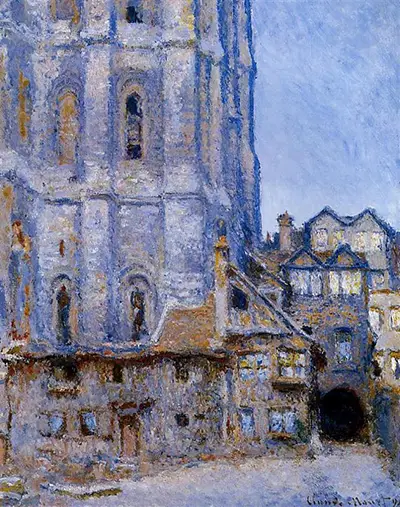It depicts a street in softened light, and its focus on the texture of the stone of the street bears many similarities with other paintings by Monet such as his series of depictions of the stone structure of Rouen cathedral.
Indeed, The Cour d'Albane is the name of a small court that exists to the side of the cathedral. So here, once more, Rouen Cathedral appears in Monet's work - albeit in a somewhat oblique form.
Probably painted in situ, as the artist stood in front of the courtyard and the rising tower, as was Monet's common practice, this painting gives us a sense of the moody, dusky light of an evening in the city.
Monet was engaged in painting a series of art works devoted to Rouen Cathedral and its environs - he completed the main body of them in 1892 and then returned to the site in 1893 in order to add to the series. In each painting, th cathedral is shown in what is quite literally a different light - in some paintings it is shown at dusk, and in others at daybreak or during the blazing noonday sun.
The differences between the colours used to express these effects of light and the vastly different impressions that they provoke in the viewer is astounding. Thus, The Cour d'Albane is part of a considered body of work which demonstrates the artist's temporary obsession with a very particular region of France.
One of the key facets of the Impressionist movement was that it involved works of art that were designed to trigger strong emotions in the viewer - often, these were emotions that the artist themself had felt whilst they were painting and thus the work of art becomes a communicative medium which enables the artist to transmit their emotions across space and time.
In The Cour d'Albane, the interplay of indigo blue and icy whitish blues creates an effect that is at once warm and receptive and chilly and obstructive. Perhaps it is hard to tell precisely what the weather was like on the day in which Monet was painting The Cour d'Albane.
But, what is unmistakable is the fact that this painting brings with it a powerful sense of the tower's imposing nature, the coldness and yet the majesty of its stone and the hidden warmth of the houses that can be glimpsed in the background of the picture.
The use of angles and the positioning of the road and tower perhaps suggests that the artist - and hence the viewer - is in transit, walking through The Cour d'Albane to get somewhere else. Perhaps, they are heading for the pitch black tunnel in the central background of the piece.
Though it is small, this tunnel draws the eye towards it thanks to its sharply dark hue, adding to the sense of mystery that - it could be argued - pervades The Cour d'Albane much more than many of Monet's other works.


